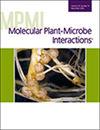Xiaoxiao Zhang, Bayantes Dagvadorj, Jialing Gao, Lucy M Molloy, Lauren M Crean, Simon J Williams, John P Rathjen
求助PDF
{"title":"Identification of a Key Gain-of-Function Residue for Effector Binding by In Vitro Shuffling of Barley <i>Mla NLR</i> Genes.","authors":"Xiaoxiao Zhang, Bayantes Dagvadorj, Jialing Gao, Lucy M Molloy, Lauren M Crean, Simon J Williams, John P Rathjen","doi":"10.1094/MPMI-11-24-0146-R","DOIUrl":null,"url":null,"abstract":"<p><p>Natural plant populations maintain high resistance (<i>R</i>) gene diversities that provide effective pathogen resistance; however, agricultural crops typically contain limited <i>R</i> gene diversity, so resistance is often short-lived, as pathogens evolve rapidly to evade recognition. The <i>Mildew resistance locus A</i> (<i>Mla</i>) <i>R</i> gene family of barley and wheat represents a rich source of natural genetic variation that is ideal for mining disease resistance specificities. <i>Mla R</i> genes encode immune receptor proteins of the nucleotide-binding leucine-rich repeat class that recognize unrelated plant pathogens by binding secreted virulence proteins termed effectors. Using DNA shuffling, we generated a variant library by recombining the barley <i>Mla7</i> and <i>Mla13</i> genes in vitro. The variant library was cloned into yeast generating approximately 4,000 independent clones and was screened for interaction with corresponding barley powdery mildew effectors AVR<sub>A13</sub> and AVR<sub>A7</sub> using a yeast two-hybrid assay. This yielded a number of MLA protein variants that interacted with AVR<sub>A13</sub>. Sequences of the interacting MLA variants can be clustered into three groups, all of which contain a critical residue from MLA13. Although MLA13 and MLA7 differ by 30 residues across the leucine-rich repeat domain, the replacement of leucine with serine at this position in MLA7 is necessary and sufficient for interaction with AVR<sub>A13</sub> in yeast and AVR<sub>A13</sub>-dependent immune signaling in planta. We have established a pipeline that evolves MLAs to recognize distinct pathogen effectors without the requirement for protein structural knowledge and the use of rational design. We suggest that these findings represent a step toward evolving novel recognition capabilities rapidly in vitro. [Formula: see text] Copyright © 2025 The Author(s). This is an open access article distributed under the CC BY-NC-ND 4.0 International license.</p>","PeriodicalId":19009,"journal":{"name":"Molecular Plant-microbe Interactions","volume":" ","pages":"454-462"},"PeriodicalIF":3.4000,"publicationDate":"2025-05-01","publicationTypes":"Journal Article","fieldsOfStudy":null,"isOpenAccess":false,"openAccessPdf":"","citationCount":"0","resultStr":null,"platform":"Semanticscholar","paperid":null,"PeriodicalName":"Molecular Plant-microbe Interactions","FirstCategoryId":"99","ListUrlMain":"https://doi.org/10.1094/MPMI-11-24-0146-R","RegionNum":3,"RegionCategory":"生物学","ArticlePicture":[],"TitleCN":null,"AbstractTextCN":null,"PMCID":null,"EPubDate":"2025/6/6 0:00:00","PubModel":"Epub","JCR":"Q2","JCRName":"BIOCHEMISTRY & MOLECULAR BIOLOGY","Score":null,"Total":0}
引用次数: 0
引用
批量引用
Abstract
Natural plant populations maintain high resistance (R ) gene diversities that provide effective pathogen resistance; however, agricultural crops typically contain limited R gene diversity, so resistance is often short-lived, as pathogens evolve rapidly to evade recognition. The Mildew resistance locus A (Mla ) R gene family of barley and wheat represents a rich source of natural genetic variation that is ideal for mining disease resistance specificities. Mla R genes encode immune receptor proteins of the nucleotide-binding leucine-rich repeat class that recognize unrelated plant pathogens by binding secreted virulence proteins termed effectors. Using DNA shuffling, we generated a variant library by recombining the barley Mla7 and Mla13 genes in vitro. The variant library was cloned into yeast generating approximately 4,000 independent clones and was screened for interaction with corresponding barley powdery mildew effectors AVRA13 and AVRA7 using a yeast two-hybrid assay. This yielded a number of MLA protein variants that interacted with AVRA13 . Sequences of the interacting MLA variants can be clustered into three groups, all of which contain a critical residue from MLA13. Although MLA13 and MLA7 differ by 30 residues across the leucine-rich repeat domain, the replacement of leucine with serine at this position in MLA7 is necessary and sufficient for interaction with AVRA13 in yeast and AVRA13 -dependent immune signaling in planta. We have established a pipeline that evolves MLAs to recognize distinct pathogen effectors without the requirement for protein structural knowledge and the use of rational design. We suggest that these findings represent a step toward evolving novel recognition capabilities rapidly in vitro. [Formula: see text] Copyright © 2025 The Author(s). This is an open access article distributed under the CC BY-NC-ND 4.0 International license.
大麦Mla NLR基因体外重组鉴定效应物结合的关键功能获得残基
天然植物种群保持高抗性(R)基因多样性,提供有效的病原体抗性;然而,农作物通常含有有限的R基因多样性,因此抗性通常是短暂的,因为病原体会迅速进化以逃避识别。大麦和小麦的抗霉位点A (Mla) R基因家族代表了丰富的自然遗传变异来源,是挖掘抗病特异性的理想选择。Mla R基因编码核苷酸结合富亮氨酸重复序列(NLR)类的免疫受体蛋白,通过结合被称为效应物的分泌毒力蛋白来识别不相关的植物病原体。利用DNA洗牌技术,对大麦Mla7和Mla13基因进行体外重组,建立了一个变异文库。将该变异文库克隆到酵母中,产生约4000个独立克隆,并通过酵母双杂交试验筛选与相应的大麦白粉病效应物AVRA13和AVRA7的相互作用。这产生了许多与AVRA13相互作用的MLA蛋白变体。相互作用的MLA变异序列可以聚为三组,它们都含有MLA13的关键残基。虽然MLA13和MLA7在LRR结构域上有30个残基的差异,但亮氨酸在MLA7中这个位置被丝氨酸取代是酵母中与AVRA13相互作用和植物中AVRA13依赖免疫信号传导的必要和充分条件。我们已经建立了一个管道,发展mla来识别不同的病原体效应物,而不需要蛋白质结构知识和使用合理的设计。我们认为这些发现代表了在体外快速进化新的识别能力的一步。
本文章由计算机程序翻译,如有差异,请以英文原文为准。

 求助内容:
求助内容: 应助结果提醒方式:
应助结果提醒方式:


